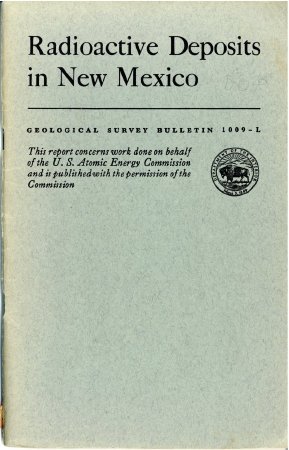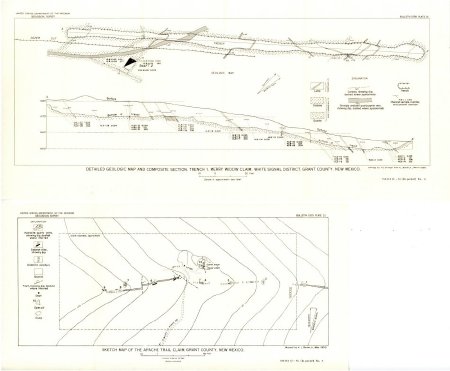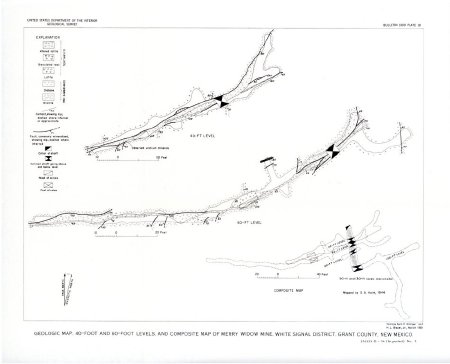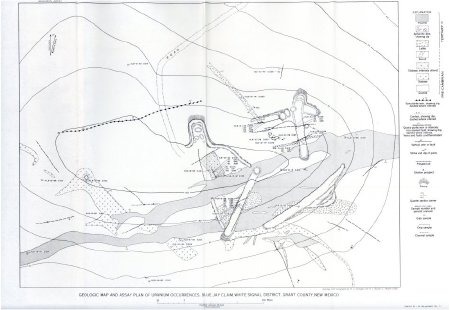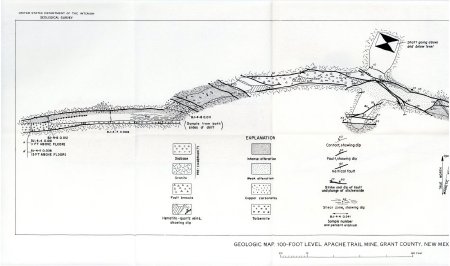Title:
Radioactive Deposits in New Mexico, A Contribution to the Geology of Uranium
Author:
T.G. Lovering
Pubication Date:
1956
Publication Place:
Washington
Publisher:
United States Government Printing Office
Summary:
The Abstract reads:
Forty-five areas of radioactivity in New Mexico had been investigated by goverment geologists or reported in the geologic literature before 1952. Twenty-one areas contained visible uranium minerals and one contained thorium minerals. The occurences were in the northwestern, noth-central, central, southwestern, and southeastern parts of the State.
The deposits in northwestern New Mexico seem to be the most promising for the mining of uranium ore. In western San Juan County, on the estern flanks of the Carrizo Mountains uplift, carontite ore has been taken from several prospects in teh Salt Wash sandstone member of the Morrison formation. On the southern rim of the San Juan Basin in Valencia and McKinley Counties, carnotite is widely ddisseminated in teh Todilto limestonee an dthe Morrison formation of Jurassic age and the Dakota formation of Cretaceous age. Farther south in the Zuni Mountains of Valencia County joint coatings in pre-Cambrian granites show show abnormal radioactivity, but no uranium minerals have been found.
Many types of radioactive deposits have been found in north-central New Mexico. This region contains 4 radioactive copper deposits, in sandstones 3 radioactive lignites or black shales, 2 radioactive spring deposits, and a uranium- and thorium-bearing pegmatite district.
In central New Mexico only two deposits, one in the San Acacia or San Lorenzo districct in Socorro County and the other in the Scholle district in Torrance County, had been reported. The former deposit consists of autunite, torbernite, and uranophane sparsely disseminated in a breccia zone near the edge of a Tertiary andesite flow; the latter consists of carnotite associated with carbonized wood and secondary copper minerals in Permian sandstones.
The radioactive deposits of southwestern New Mexico include the White Signal and Black Hawk districs in Grant County and the Terry prospect in Sierra County. In the White Signal district autunite and torbernite are associated with veins and basic dikes cutting pre-Cambrian granite and diabase. In the Black Hawk district pitchblende is associated with nickel, cobalt, and silver minerals in quartz veins cutting pre-Cambrian granite. On the Terry prospect, near Monteicellom, urnaophane occurs in a breccia zone cutting limestones of Mississippian age, which have been altered to jasperoid.
In many of the Lea County oilfields of southeastern New Mexico the brines, which are associated with oil from Permian strata, are radioactive; however, the uranium content of these brines is extremely low, and it seems unlikely that they will ever become a commercial source of uranium.
The only commercial deposits of uranium ore in New Mexico, known before 1952, are in teh northwestern part of the State. A plant has been constructed near Grants, in Valencia County, to process this ore. The few tons of ore available on the Merry Widow claim in the White Signal district and the presence of pitchblende at Black Hawk suggest that further exploration here may discover important ore reserves. Information available on the rest of New Mexico does not indicate the presence of any important sources of uranium ore under market conditions prevailing at the end of 1951.
The Introduction begins:
The purpose of this report is to summarize the information available on uranium deposits and uranium mining activity in New Mexico before 1952.
Forty-five areas of radioactivity in New Mexico had been investigated by goverment geologists or reported in the geologic literature before 1952. Twenty-one areas contained visible uranium minerals and one contained thorium minerals. The occurences were in the northwestern, noth-central, central, southwestern, and southeastern parts of the State.
The deposits in northwestern New Mexico seem to be the most promising for the mining of uranium ore. In western San Juan County, on the estern flanks of the Carrizo Mountains uplift, carontite ore has been taken from several prospects in teh Salt Wash sandstone member of the Morrison formation. On the southern rim of the San Juan Basin in Valencia and McKinley Counties, carnotite is widely ddisseminated in teh Todilto limestonee an dthe Morrison formation of Jurassic age and the Dakota formation of Cretaceous age. Farther south in the Zuni Mountains of Valencia County joint coatings in pre-Cambrian granites show show abnormal radioactivity, but no uranium minerals have been found.
Many types of radioactive deposits have been found in north-central New Mexico. This region contains 4 radioactive copper deposits, in sandstones 3 radioactive lignites or black shales, 2 radioactive spring deposits, and a uranium- and thorium-bearing pegmatite district.
In central New Mexico only two deposits, one in the San Acacia or San Lorenzo districct in Socorro County and the other in the Scholle district in Torrance County, had been reported. The former deposit consists of autunite, torbernite, and uranophane sparsely disseminated in a breccia zone near the edge of a Tertiary andesite flow; the latter consists of carnotite associated with carbonized wood and secondary copper minerals in Permian sandstones.
The radioactive deposits of southwestern New Mexico include the White Signal and Black Hawk districs in Grant County and the Terry prospect in Sierra County. In the White Signal district autunite and torbernite are associated with veins and basic dikes cutting pre-Cambrian granite and diabase. In the Black Hawk district pitchblende is associated with nickel, cobalt, and silver minerals in quartz veins cutting pre-Cambrian granite. On the Terry prospect, near Monteicellom, urnaophane occurs in a breccia zone cutting limestones of Mississippian age, which have been altered to jasperoid.
In many of the Lea County oilfields of southeastern New Mexico the brines, which are associated with oil from Permian strata, are radioactive; however, the uranium content of these brines is extremely low, and it seems unlikely that they will ever become a commercial source of uranium.
The only commercial deposits of uranium ore in New Mexico, known before 1952, are in teh northwestern part of the State. A plant has been constructed near Grants, in Valencia County, to process this ore. The few tons of ore available on the Merry Widow claim in the White Signal district and the presence of pitchblende at Black Hawk suggest that further exploration here may discover important ore reserves. Information available on the rest of New Mexico does not indicate the presence of any important sources of uranium ore under market conditions prevailing at the end of 1951.
The Introduction begins:
The purpose of this report is to summarize the information available on uranium deposits and uranium mining activity in New Mexico before 1952.
Collection:
Dr. Jay Shelton
